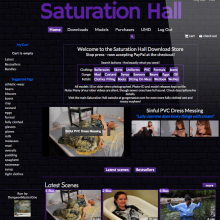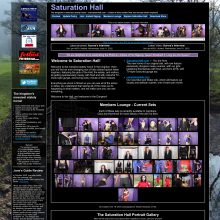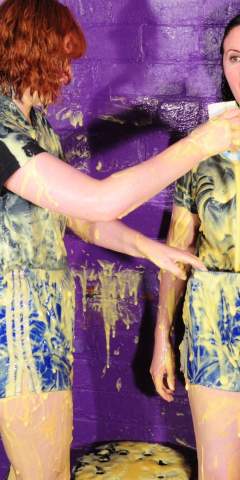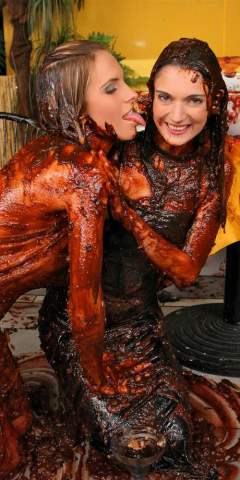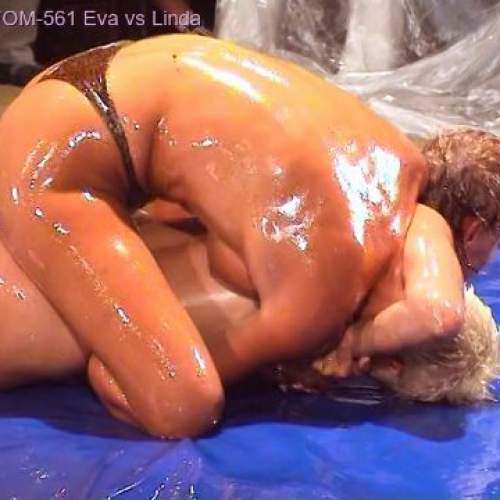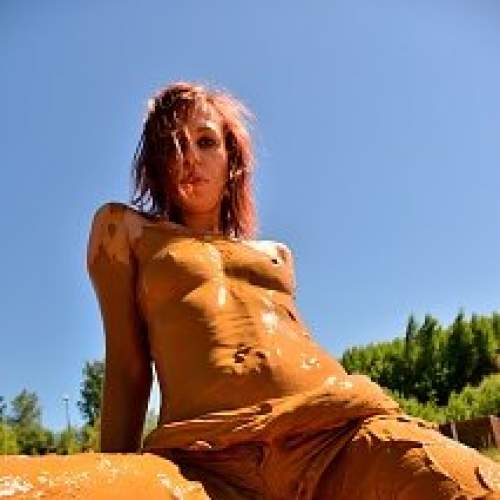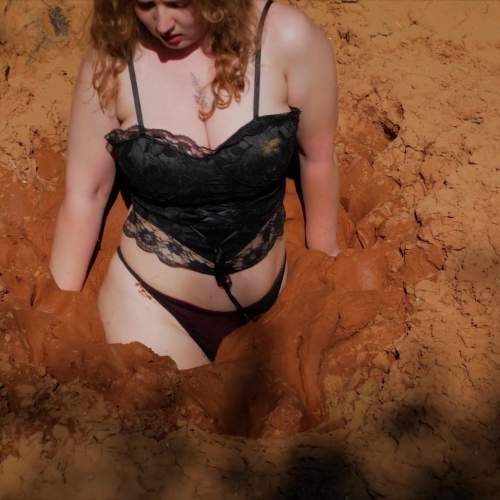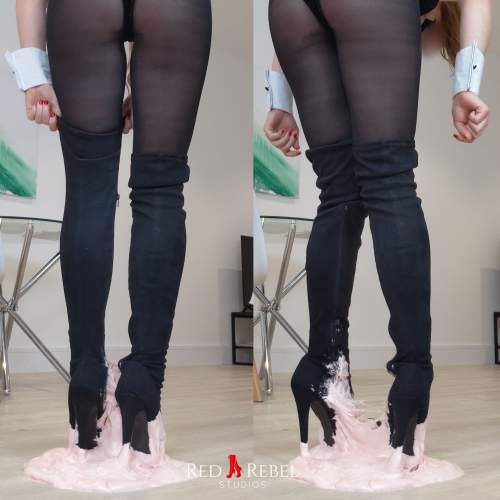|
|
|||
| forums: groups: | |||
|
"Heated Mud Pit?"
Anyone have experience with heating an outdoor mud pit? If not, what ideas would you propose to do so with a dream budget $$$.
I'm thinking that you'd need to insulate somehow and then run pex tubing on the bottom/sides. Then pump warm water from either an electric water heater or maybe a heat pump. Let me know your thoughts
If anyone has one and is open for visitors, I can travel almost anywhere
I'm thinking that you'd need to insulate somehow and then run pex tubing on the bottom/sides. Then pump warm water from either an electric water heater or maybe a heat pump. Let me know your thoughts
If anyone has one and is open for visitors, I can travel almost anywhere

Saturation Hall, Langstonedale
Lord of the Pies
You want to go back through MudMadPhil's posts, he built a solar-heated mud pit in Texas a few years ago, and another in Florida more recently. The solar heat was by hot water, not electric cells, heat collectors on the roof of a building which then heated the mud by below-pit pipes, I gather it worked quite well.
https://umd.net/mudmadphil
Phil also worked with the legendary Rob Blaine back in the day.
https://umd.net/mudmadphil
Phil also worked with the legendary Rob Blaine back in the day.
Saturation Hall - Forth! The Gungemaidens!
Tried many times over 30 years, nothing cheap will work, mud/clay is very hard to heat. If you figure it out let me know and I can move away from Florida!
I'll have to try and find the post that has the details, thanks for that.
Interesting using solar power for that kind of setup. I wonder if that is feasible in the mid Atlantic states that get colder like 30's. Ideally this could be used year around through the winter. Yeah this would be a dream setup for sure with the cost.
But just imagine a hot tub like mud pit, maybe add some bubbles
Interesting using solar power for that kind of setup. I wonder if that is feasible in the mid Atlantic states that get colder like 30's. Ideally this could be used year around through the winter. Yeah this would be a dream setup for sure with the cost.
But just imagine a hot tub like mud pit, maybe add some bubbles

Heating is very difficult, because the viscosity of mud means there's almost no spread of warmth by convection. However, for the same reason, mud is slow to lose its warmth once hot. I made a small hot-tub a while ago. It's insulated all round with 2" insulation board, with a lid of the same. Even with hot water in it stays comfortably warm for almost 24 hours. I'd expect that mud would stay warm for much longer. In fact, you might have just inspired me to try it! So maybe don't focus on trying to heat the mud pit, instead just make the mud with hot water and enjoy a couple of days of fun in your insulated pit before it cools down.
Planning to build an lndoor one in the coming years.. in Canada.. outdoor would still be couple months only. My plan is to insulate under and around the pool and have a water bed heat pad under the pool. Might need 2 as those are not that large. Adding a 2in foam on top to keep the heat when not using it. The room would also need to have some additional heating to keep it enjoyable. So I would think insulate under, around and above.. put the heated pad just under your plastic tarp and you will get something interresting that wont be complexe with pipes pumps and such.
For me I'd like something permanent that can be enjoyed all year around. It'd be hard to do that indoors without building a custom room or something. Maybe an outdoor greenhouse with a couple pits.
I agree insulation is key, wonder if spray foam could be used on a concrete pit or just bare dirt. I guess I worry that any foam would be compressed by the weight of the mud making it ineffective.
I agree insulation is key, wonder if spray foam could be used on a concrete pit or just bare dirt. I guess I worry that any foam would be compressed by the weight of the mud making it ineffective.
Been there, done it all including the outdoor pool. Simply put, an outdoor pool is impossible to warm up even with putting plastic on top to try to turn it into a greenhouse. This is because the clay is in contact with the ground and the ground temperature determines the clay temperature. All the greenhouse thing does is warm the air up and has minimal effect on the ground...
I used to have a four ton mudbath in the garage but it was only possible to heat the top surface a little even with insulation all around. I then solved the problem with an indoor heated 1-ton mudbath using first a pump and then switching to thermal convection to circulate hot water in flexible pvc piping around the sides of the mudbath...
Nothing outdoors will work all that much better than the outdoor pool. If you want to heat something outdoor you will need to build an insulated structure with particular attention being given to totally isolating and insulating the bottom of the mudbath from the ground. My solution of surrounding the mud tub with heated circulating water will probably be the cheapest but I'm not an engineer and there may be better thermal techniques I'm not aware of...
I used to have a four ton mudbath in the garage but it was only possible to heat the top surface a little even with insulation all around. I then solved the problem with an indoor heated 1-ton mudbath using first a pump and then switching to thermal convection to circulate hot water in flexible pvc piping around the sides of the mudbath...
Nothing outdoors will work all that much better than the outdoor pool. If you want to heat something outdoor you will need to build an insulated structure with particular attention being given to totally isolating and insulating the bottom of the mudbath from the ground. My solution of surrounding the mud tub with heated circulating water will probably be the cheapest but I'm not an engineer and there may be better thermal techniques I'm not aware of...
Ghost00 said: Love these kinds of discussions. Would it not be effective to have an indoor mud pit that gets "freshened up" with very hot water prior to playing in? Kind of like a hot tub with no bubbles. Yeah it wouldn't keep the heat for very long but would it at least be a temporary solution that lasts long enough for a nice mud wallow and soak?
If I were going through the trouble of building a pit, I'd want it to be usable whenever the desire hits me. Having to heat water and put on top, then mix it through feels like too much effort. Not to mention now the mud is thinner than I may have wanted since I needed to add water to heat it. I like thick stuff

quarryman said: Been there, done it all including the outdoor pool. Simply put, an outdoor pool is impossible to warm up even with putting plastic on top to try to turn it into a greenhouse. This is because the clay is in contact with the ground and the ground temperature determines the clay temperature. All the greenhouse thing does is warm the air up and has minimal effect on the ground...
I used to have a four ton mudbath in the garage but it was only possible to heat the top surface a little even with insulation all around. I then solved the problem with an indoor heated 1-ton mudbath using first a pump and then switching to thermal convection to circulate hot water in flexible pvc piping around the sides of the mudbath...
Nothing outdoors will work all that much better than the outdoor pool. If you want to heat something outdoor you will need to build an insulated structure with particular attention being given to totally isolating and insulating the bottom of the mudbath from the ground. My solution of surrounding the mud tub with heated circulating water will probably be the cheapest but I'm not an engineer and there may be better thermal techniques I'm not aware of...
I used to have a four ton mudbath in the garage but it was only possible to heat the top surface a little even with insulation all around. I then solved the problem with an indoor heated 1-ton mudbath using first a pump and then switching to thermal convection to circulate hot water in flexible pvc piping around the sides of the mudbath...
Nothing outdoors will work all that much better than the outdoor pool. If you want to heat something outdoor you will need to build an insulated structure with particular attention being given to totally isolating and insulating the bottom of the mudbath from the ground. My solution of surrounding the mud tub with heated circulating water will probably be the cheapest but I'm not an engineer and there may be better thermal techniques I'm not aware of...
Thanks for the response! I agree, there needs to be active heating involved for this to work to my satisfaction. I get cold easily so having cold/cool mud (depending on the season) really kills the mood for me.
Would you mind going into detail about your indoor heated setup?
I was thinking similar, using pex tubing with hot water or some frost-proof solution going around the sides and bottom of a pit. Being run by some kind of pump. You could generate the hot water with an electric water heater. Ongoing heating costs could be reduced if you had a solar array (since I'd be using an electric water heater) but that's another can of worms.
This whole thing would probably need to be in a building of some kind. At least to help insulate from the outside and take less work of whatever heating arrangement for the mud pit. Also to shelter the electrical components from the elements. Perhaps a greenhouse could be used? I don't know if it would insulate enough during winter. Any thoughts are welcome!
MudLust said:
Thanks for the response! I agree, there needs to be active heating involved for this to work to my satisfaction. I get cold easily so having cold/cool mud (depending on the season) really kills the mood for me.
Would you mind going into detail about your indoor heated setup?
I was thinking similar, using pex tubing with hot water or some frost-proof solution going around the sides and bottom of a pit. Being run by some kind of pump. You could generate the hot water with an electric water heater. Ongoing heating costs could be reduced if you had a solar array (since I'd be using an electric water heater) but that's another can of worms.
This whole thing would probably need to be in a building of some kind. At least to help insulate from the outside and take less work of whatever heating arrangement for the mud pit. Also to shelter the electrical components from the elements. Perhaps a greenhouse could be used? I don't know if it would insulate enough during winter. Any thoughts are welcome!
quarryman said: Been there, done it all including the outdoor pool. Simply put, an outdoor pool is impossible to warm up even with putting plastic on top to try to turn it into a greenhouse. This is because the clay is in contact with the ground and the ground temperature determines the clay temperature. All the greenhouse thing does is warm the air up and has minimal effect on the ground...
I used to have a four ton mudbath in the garage but it was only possible to heat the top surface a little even with insulation all around. I then solved the problem with an indoor heated 1-ton mudbath using first a pump and then switching to thermal convection to circulate hot water in flexible pvc piping around the sides of the mudbath...
Nothing outdoors will work all that much better than the outdoor pool. If you want to heat something outdoor you will need to build an insulated structure with particular attention being given to totally isolating and insulating the bottom of the mudbath from the ground. My solution of surrounding the mud tub with heated circulating water will probably be the cheapest but I'm not an engineer and there may be better thermal techniques I'm not aware of...
I used to have a four ton mudbath in the garage but it was only possible to heat the top surface a little even with insulation all around. I then solved the problem with an indoor heated 1-ton mudbath using first a pump and then switching to thermal convection to circulate hot water in flexible pvc piping around the sides of the mudbath...
Nothing outdoors will work all that much better than the outdoor pool. If you want to heat something outdoor you will need to build an insulated structure with particular attention being given to totally isolating and insulating the bottom of the mudbath from the ground. My solution of surrounding the mud tub with heated circulating water will probably be the cheapest but I'm not an engineer and there may be better thermal techniques I'm not aware of...
Thanks for the response! I agree, there needs to be active heating involved for this to work to my satisfaction. I get cold easily so having cold/cool mud (depending on the season) really kills the mood for me.
Would you mind going into detail about your indoor heated setup?
I was thinking similar, using pex tubing with hot water or some frost-proof solution going around the sides and bottom of a pit. Being run by some kind of pump. You could generate the hot water with an electric water heater. Ongoing heating costs could be reduced if you had a solar array (since I'd be using an electric water heater) but that's another can of worms.
This whole thing would probably need to be in a building of some kind. At least to help insulate from the outside and take less work of whatever heating arrangement for the mud pit. Also to shelter the electrical components from the elements. Perhaps a greenhouse could be used? I don't know if it would insulate enough during winter. Any thoughts are welcome!
Electric heated floor would be easier to install under your pool than the whole PVC, pump and heater system. An alternative to that is the water bed heater. You even have a temp proble and a controller in most kits. It is surprisingly effective under my pool of slime or mud. It is used by others, I can't remember who shared that tip here, I think it was Candy.
I have had success with heating an indoor mud pit using two waterbed heaters - it takes a while for the mud to warm up and the heat is more localised due to the muds thickness. Overall though, its meant that I can enjoy the mud even during the coldest months of winter.
You're welcome to message me if you want more info.
Cheers
MBx
You're welcome to message me if you want more info.
Cheers
MBx
I know this is not the same thing. I have an outdoor, inflatable hot tub in a heavily insulated little 'barn' style shed. The floor is built like a deck, but with joists closer together to hold up the 2000 pounds of water. The floor is insulated but not heated. If I were to build this for a mud pool, I'd absolutely insulate the floor. My walls are 4" thick insulation, vapor barrier, etc. just like a house. The attic had about two feet of fiberglass. I'm in Canada and even in the winter, this remains hot, and the hot-tub heater isn't on often. (I monitor it from inside the house) There is also a little space-heater in there for the air temperature, and it also seldom comes on.
My point is that if a mud pit is located in a warm room where all surfaces are insulated from anything less warm, then the clay in the pit can't get cold. It's like a carton of ice cream left on the counter, it will match the house temperature, warm up and melt.
So my suggestion is to heavily insulate the space where the mud pit is going, especially the floor if the floor of the room is in contact with the earth (basement) or not generating heat of its own. If the room stays heated up to a high degree, then the mud temperature will have to match. It's physics.
My point is that if a mud pit is located in a warm room where all surfaces are insulated from anything less warm, then the clay in the pit can't get cold. It's like a carton of ice cream left on the counter, it will match the house temperature, warm up and melt.
So my suggestion is to heavily insulate the space where the mud pit is going, especially the floor if the floor of the room is in contact with the earth (basement) or not generating heat of its own. If the room stays heated up to a high degree, then the mud temperature will have to match. It's physics.
wam_guevara said:
Electric heated floor would be easier to install under your pool than the whole PVC, pump and heater system. An alternative to that is the water bed heater. You even have a temp proble and a controller in most kits. It is surprisingly effective under my pool of slime or mud. It is used by others, I can't remember who shared that tip here, I think it was Candy.
MudLust said:
Thanks for the response! I agree, there needs to be active heating involved for this to work to my satisfaction. I get cold easily so having cold/cool mud (depending on the season) really kills the mood for me.
Would you mind going into detail about your indoor heated setup?
I was thinking similar, using pex tubing with hot water or some frost-proof solution going around the sides and bottom of a pit. Being run by some kind of pump. You could generate the hot water with an electric water heater. Ongoing heating costs could be reduced if you had a solar array (since I'd be using an electric water heater) but that's another can of worms.
This whole thing would probably need to be in a building of some kind. At least to help insulate from the outside and take less work of whatever heating arrangement for the mud pit. Also to shelter the electrical components from the elements. Perhaps a greenhouse could be used? I don't know if it would insulate enough during winter. Any thoughts are welcome!
quarryman said: Been there, done it all including the outdoor pool. Simply put, an outdoor pool is impossible to warm up even with putting plastic on top to try to turn it into a greenhouse. This is because the clay is in contact with the ground and the ground temperature determines the clay temperature. All the greenhouse thing does is warm the air up and has minimal effect on the ground...
I used to have a four ton mudbath in the garage but it was only possible to heat the top surface a little even with insulation all around. I then solved the problem with an indoor heated 1-ton mudbath using first a pump and then switching to thermal convection to circulate hot water in flexible pvc piping around the sides of the mudbath...
Nothing outdoors will work all that much better than the outdoor pool. If you want to heat something outdoor you will need to build an insulated structure with particular attention being given to totally isolating and insulating the bottom of the mudbath from the ground. My solution of surrounding the mud tub with heated circulating water will probably be the cheapest but I'm not an engineer and there may be better thermal techniques I'm not aware of...
I used to have a four ton mudbath in the garage but it was only possible to heat the top surface a little even with insulation all around. I then solved the problem with an indoor heated 1-ton mudbath using first a pump and then switching to thermal convection to circulate hot water in flexible pvc piping around the sides of the mudbath...
Nothing outdoors will work all that much better than the outdoor pool. If you want to heat something outdoor you will need to build an insulated structure with particular attention being given to totally isolating and insulating the bottom of the mudbath from the ground. My solution of surrounding the mud tub with heated circulating water will probably be the cheapest but I'm not an engineer and there may be better thermal techniques I'm not aware of...
Thanks for the response! I agree, there needs to be active heating involved for this to work to my satisfaction. I get cold easily so having cold/cool mud (depending on the season) really kills the mood for me.
Would you mind going into detail about your indoor heated setup?
I was thinking similar, using pex tubing with hot water or some frost-proof solution going around the sides and bottom of a pit. Being run by some kind of pump. You could generate the hot water with an electric water heater. Ongoing heating costs could be reduced if you had a solar array (since I'd be using an electric water heater) but that's another can of worms.
This whole thing would probably need to be in a building of some kind. At least to help insulate from the outside and take less work of whatever heating arrangement for the mud pit. Also to shelter the electrical components from the elements. Perhaps a greenhouse could be used? I don't know if it would insulate enough during winter. Any thoughts are welcome!
Electric heated floor would be easier to install under your pool than the whole PVC, pump and heater system. An alternative to that is the water bed heater. You even have a temp proble and a controller in most kits. It is surprisingly effective under my pool of slime or mud. It is used by others, I can't remember who shared that tip here, I think it was Candy.
I hadn't considered using an electric floor. My dream setup would be some concrete pits that have a heating system embedded to warm various muds. I wonder if using an electric floor in that context is viable or if it would be too inefficient compared to hot water. Some more research needed for sure.
As far as the waterbed heaters, how hot do they make the pit? From my preliminary googling, I don't know if they could heat the mud warm enough for me.
12/13/23, 2:13am: This post won't bump the thread to the top.
MuddyBob said: I have had success with heating an indoor mud pit using two waterbed heaters - it takes a while for the mud to warm up and the heat is more localised due to the muds thickness. Overall though, its meant that I can enjoy the mud even during the coldest months of winter.
You're welcome to message me if you want more info.
Cheers
MBx
You're welcome to message me if you want more info.
Cheers
MBx
Thanks for this

Bobographer said: I know this is not the same thing. I have an outdoor, inflatable hot tub in a heavily insulated little 'barn' style shed. The floor is built like a deck, but with joists closer together to hold up the 2000 pounds of water. The floor is insulated but not heated. If I were to build this for a mud pool, I'd absolutely insulate the floor. My walls are 4" thick insulation, vapor barrier, etc. just like a house. The attic had about two feet of fiberglass. I'm in Canada and even in the winter, this remains hot, and the hot-tub heater isn't on often. (I monitor it from inside the house) There is also a little space-heater in there for the air temperature, and it also seldom comes on.
My point is that if a mud pit is located in a warm room where all surfaces are insulated from anything less warm, then the clay in the pit can't get cold. It's like a carton of ice cream left on the counter, it will match the house temperature, warm up and melt.
So my suggestion is to heavily insulate the space where the mud pit is going, especially the floor if the floor of the room is in contact with the earth (basement) or not generating heat of its own. If the room stays heated up to a high degree, then the mud temperature will have to match. It's physics.
My point is that if a mud pit is located in a warm room where all surfaces are insulated from anything less warm, then the clay in the pit can't get cold. It's like a carton of ice cream left on the counter, it will match the house temperature, warm up and melt.
So my suggestion is to heavily insulate the space where the mud pit is going, especially the floor if the floor of the room is in contact with the earth (basement) or not generating heat of its own. If the room stays heated up to a high degree, then the mud temperature will have to match. It's physics.
Yeah makes sense to me. Ample insulation will be key.
How do you handle moisture in your shed? That was also a concern for me in building some outdoor mud pits. If they are insulated and pretty air tight, then how do manage the inevitable moisture buildup from a would be mud pit(s)? I wouldn't want mold/mildew to grow from the humidity over time.
I tried a waterbed electric heater early on and it didn't work as it only heated a small area, used a lot of electricity for little effect, and dried out and ruined the vinyl pool liner I lined my mudbath with. A 20 gallon electric heater proved adequate for my one ton mudbath and I eventually discovered that I didn't need to use the pump to circulate the hot water, it circulated adequately through thermal convection...
A heated floor would be an interesting experiment as it would also heat the room but I've got my doubts as to whether it would heat the mud adequately...
A thermal barrier is needed over a mudbath when not in use, just some heavy plastic sheeting worked well for me. With the cover over it, the water vapor coming off the mud will condense and fall back down crating a thin layer of water on the surface that helps keep the mud from drying out as fast...
A heated floor would be an interesting experiment as it would also heat the room but I've got my doubts as to whether it would heat the mud adequately...
A thermal barrier is needed over a mudbath when not in use, just some heavy plastic sheeting worked well for me. With the cover over it, the water vapor coming off the mud will condense and fall back down crating a thin layer of water on the surface that helps keep the mud from drying out as fast...
MudLust said:
Yeah makes sense to me. Ample insulation will be key.
How do you handle moisture in your shed? That was also a concern for me in building some outdoor mud pits. If they are insulated and pretty air tight, then how do manage the inevitable moisture buildup from a would be mud pit(s)? I wouldn't want mold/mildew to grow from the humidity over time.
I used wood walls inside, with vapor barrier between the walls and the insulation. Walls and celing were primed with oil-based primer, and painted with regular latex paint. It gets very humid in there, but we've never had any issues with funky smells, mold, etc. perhaps in part due to the chemical treatment of the water, since the humidity is basically coming from treated water. Our floor is pressure-treated decking over another layer of pressure-treated decking going the other direction, and all is covered with a vinyl sheet that just sits on top.
If it's a room within a room, then you could use a small fan to exchange the air and get rid of some of the humidity if necessary. There would be no loss of heat if the mud room and the room it is in are at the same temperature.
quarryman said: I tried a waterbed electric heater early on and it didn't work as it only heated a small area, used a lot of electricity for little effect, and dried out and ruined the vinyl pool liner I lined my mudbath with. A 20 gallon electric heater proved adequate for my one ton mudbath and I eventually discovered that I didn't need to use the pump to circulate the hot water, it circulated adequately through thermal convection...
A heated floor would be an interesting experiment as it would also heat the room but I've got my doubts as to whether it would heat the mud adequately...
A thermal barrier is needed over a mudbath when not in use, just some heavy plastic sheeting worked well for me. With the cover over it, the water vapor coming off the mud will condense and fall back down crating a thin layer of water on the surface that helps keep the mud from drying out as fast...
A heated floor would be an interesting experiment as it would also heat the room but I've got my doubts as to whether it would heat the mud adequately...
A thermal barrier is needed over a mudbath when not in use, just some heavy plastic sheeting worked well for me. With the cover over it, the water vapor coming off the mud will condense and fall back down crating a thin layer of water on the surface that helps keep the mud from drying out as fast...
That would be my fear with a waterbed heater at large scale. It would definitely suck going through the effort of building the mud pit and filling to only find out it's not heating efficiently.
Great idea on a thermal cover, will keep other debris out when not in use as well.
Bobographer said:
Yeah makes sense to me. Ample insulation will be key.
How do you handle moisture in your shed? That was also a concern for me in building some outdoor mud pits. If they are insulated and pretty air tight, then how do manage the inevitable moisture buildup from a would be mud pit(s)? I wouldn't want mold/mildew to grow from the humidity over time.
MudLust said:
Yeah makes sense to me. Ample insulation will be key.
How do you handle moisture in your shed? That was also a concern for me in building some outdoor mud pits. If they are insulated and pretty air tight, then how do manage the inevitable moisture buildup from a would be mud pit(s)? I wouldn't want mold/mildew to grow from the humidity over time.
I used wood walls inside, with vapor barrier between the walls and the insulation. Walls and celing were primed with oil-based primer, and painted with regular latex paint. It gets very humid in there, but we've never had any issues with funky smells, mold, etc. perhaps in part due to the chemical treatment of the water, since the humidity is basically coming from treated water. Our floor is pressure-treated decking over another layer of pressure-treated decking going the other direction, and all is covered with a vinyl sheet that just sits on top.
If it's a room within a room, then you could use a small fan to exchange the air and get rid of some of the humidity if necessary. There would be no loss of heat if the mud room and the room it is in are at the same temperature.
Cool thanks for the info!
This is so interesting.
Realize no one other then a few select locations (commercially) even has mud baths? I always wondered. People have custom steam rooms, 15,000 jacuzzi or 60,000 pools. What if you could have a personal mud bath?
Who would want one? What would be an appropriate price? 10,15,20 thousand? Cleanup?
How much would a person pay a company to design, install and fill a personal mud bath? Has it ever been done?
The thing I've thought about are sanitary questions. If it's your own personal mud bath were you are there to just bath, possibly showering before each bath then you wouldn't have to turn the mud over. I think of the pink panther movie with Joanne lumley. But if this is geared more towards mud bathing, fetish and possible sex with your partner you would want to turn the mud over quicker like Howard the ducks lava of love. I've thought about this for years. What if you are a company that does this? Could you survive? Interesting. We would love an indoor mud pit, especially heated in inside in the Michigan winter. As it is my wife and I open our outdoor mud bath in June and close it in September. We basically dig and till up a 8x8 area about 2' deep. We have a fenced in yard and no kids. So being nude and wallowing in mud outdoors isn't a problem. You have to use caution with the outdoor mud cause animals love to visit it and in our case and it happened last summer geese like to visit. Funny story my wife decided to use the mud bath. She got in completely covered with glistening brownish black mud. Some geese flew over head. My wife looked up and got her entire face completely shit on! It looked like a giant gave her a facial. I helped her clean up but what an experience
Realize no one other then a few select locations (commercially) even has mud baths? I always wondered. People have custom steam rooms, 15,000 jacuzzi or 60,000 pools. What if you could have a personal mud bath?
Who would want one? What would be an appropriate price? 10,15,20 thousand? Cleanup?
How much would a person pay a company to design, install and fill a personal mud bath? Has it ever been done?
The thing I've thought about are sanitary questions. If it's your own personal mud bath were you are there to just bath, possibly showering before each bath then you wouldn't have to turn the mud over. I think of the pink panther movie with Joanne lumley. But if this is geared more towards mud bathing, fetish and possible sex with your partner you would want to turn the mud over quicker like Howard the ducks lava of love. I've thought about this for years. What if you are a company that does this? Could you survive? Interesting. We would love an indoor mud pit, especially heated in inside in the Michigan winter. As it is my wife and I open our outdoor mud bath in June and close it in September. We basically dig and till up a 8x8 area about 2' deep. We have a fenced in yard and no kids. So being nude and wallowing in mud outdoors isn't a problem. You have to use caution with the outdoor mud cause animals love to visit it and in our case and it happened last summer geese like to visit. Funny story my wife decided to use the mud bath. She got in completely covered with glistening brownish black mud. Some geese flew over head. My wife looked up and got her entire face completely shit on! It looked like a giant gave her a facial. I helped her clean up but what an experience
Been there, done that. I had a 4-ton mudbath in my garage and a 1-ton mudbath in my house, only the one in the house was able to be adequately heated. I once set up a massage business and trained the owner in mud massage technique but she became aware of the existence of a mud sexual fetish and immediately got rid of the mud to protect her massage license...
Mud is difficult to work with because it is messy and heavy but it can be done. There is at least one spa in Calistoga, California (Doc Wilkerson's) that offers real mudbaths but they don't use a creamy clay. I am confident a mud spa could be successful but it would have to be located in the right place and be part of some sort of New Age hot tub and/or massage business...
Cleanup and keeping the mud contained in a specific area is the main challenge. The best solution would be to locate the mudbath(s) in a tile room with a central floor drain and then to then either have a shower available for them or use a hose to wash them off like is done in some spas. The main thing is to wash any clay that gets outside of the mudbath away before it dries. I never had any problem managing transiting from the mudbath to the shower in my house but it does require care and proper procedures...
As long a pottery clay is used, keeping mud clean is not that difficult as clay is anaerobic. I would occasionally stir some bleach in but that really isn't necessary unless the mudbath is being used commercially. If used for the public, you will have to come up with a heating or some other method of satisfying local health authorities that it is safe...
Mud is difficult to work with because it is messy and heavy but it can be done. There is at least one spa in Calistoga, California (Doc Wilkerson's) that offers real mudbaths but they don't use a creamy clay. I am confident a mud spa could be successful but it would have to be located in the right place and be part of some sort of New Age hot tub and/or massage business...
Cleanup and keeping the mud contained in a specific area is the main challenge. The best solution would be to locate the mudbath(s) in a tile room with a central floor drain and then to then either have a shower available for them or use a hose to wash them off like is done in some spas. The main thing is to wash any clay that gets outside of the mudbath away before it dries. I never had any problem managing transiting from the mudbath to the shower in my house but it does require care and proper procedures...
As long a pottery clay is used, keeping mud clean is not that difficult as clay is anaerobic. I would occasionally stir some bleach in but that really isn't necessary unless the mudbath is being used commercially. If used for the public, you will have to come up with a heating or some other method of satisfying local health authorities that it is safe...
Sponsors
Sponsors

Design & Code ©1998-2025 Loverbuns, LLC 18 U.S.C. 2257 Record-Keeping Requirements Compliance Statement
Epoch Billing Support Log In





 Love you, too
Love you, too
